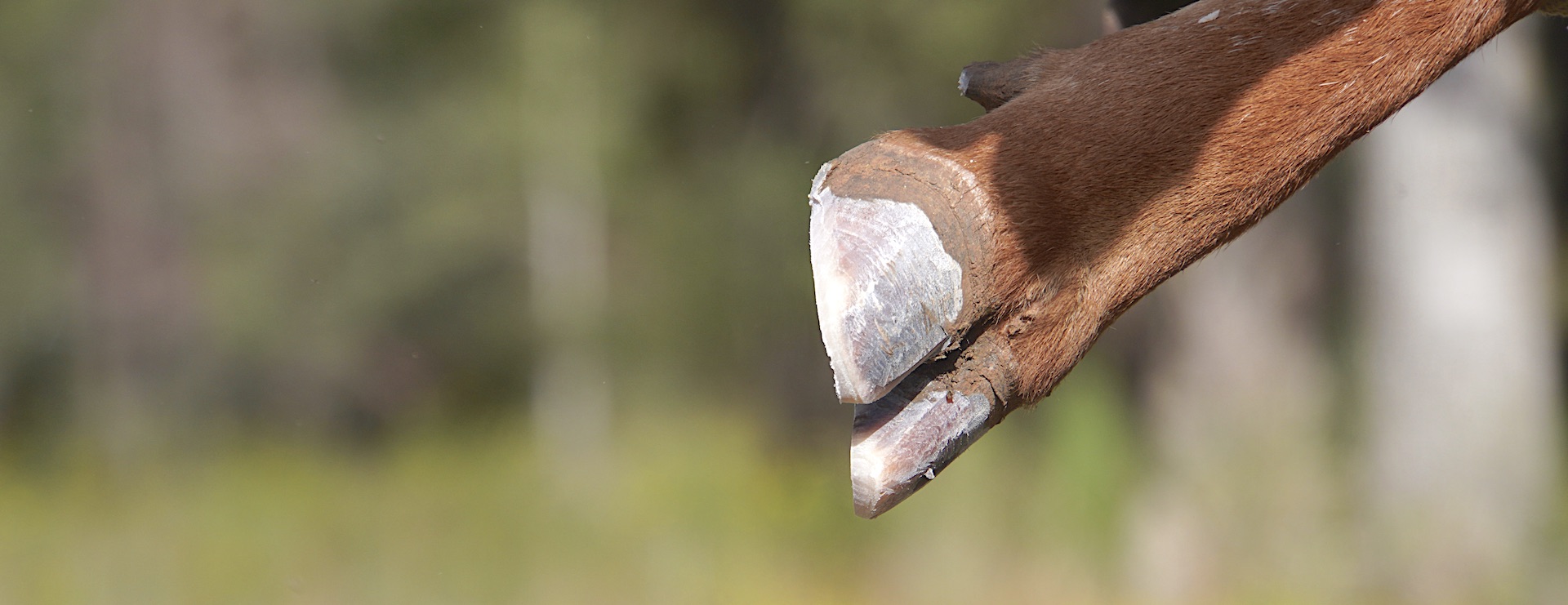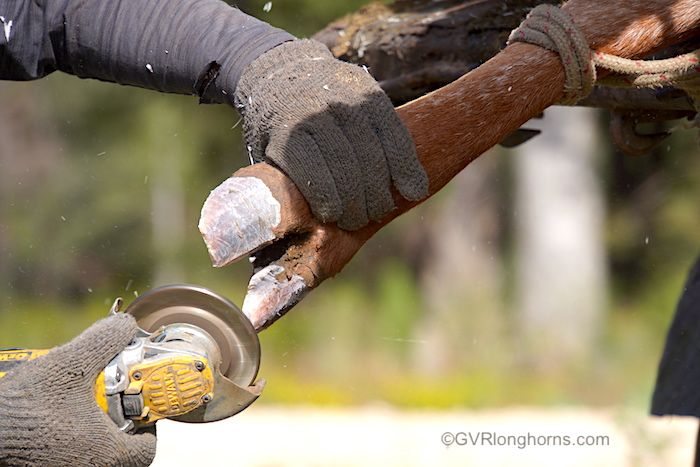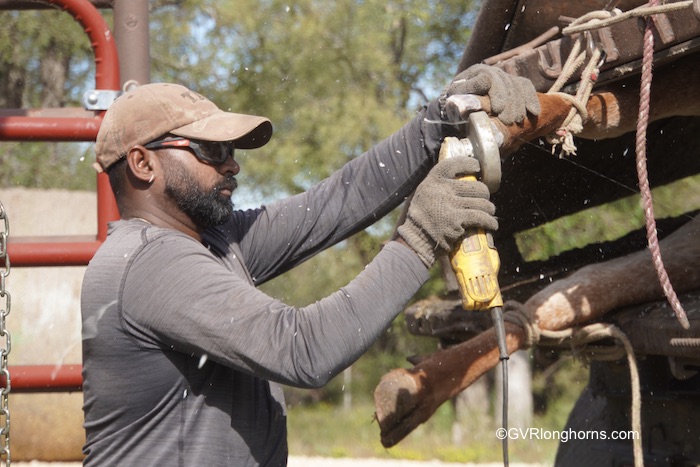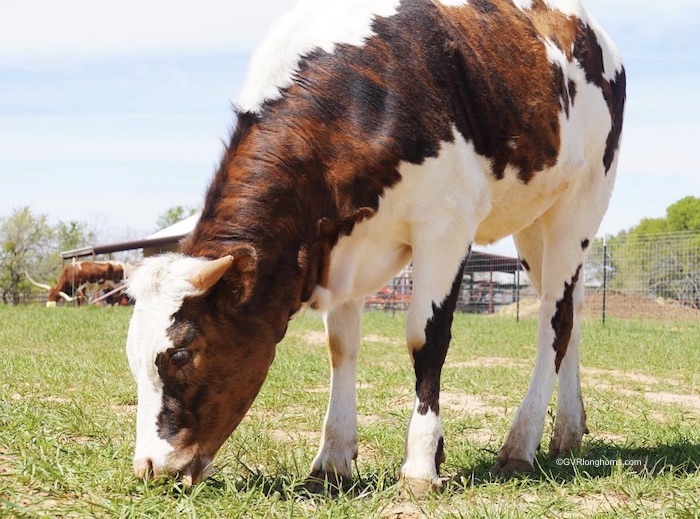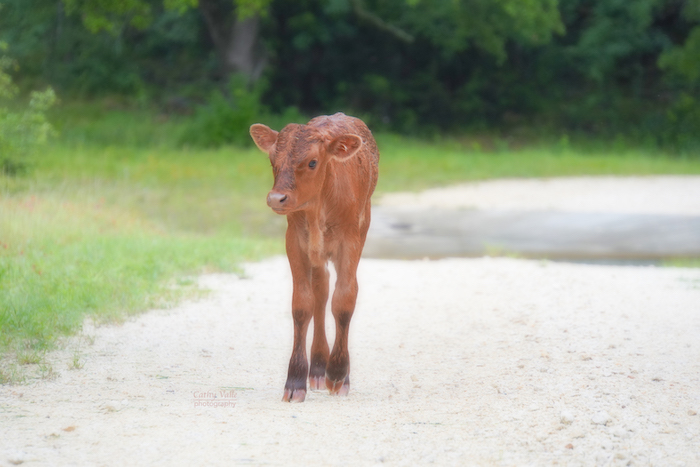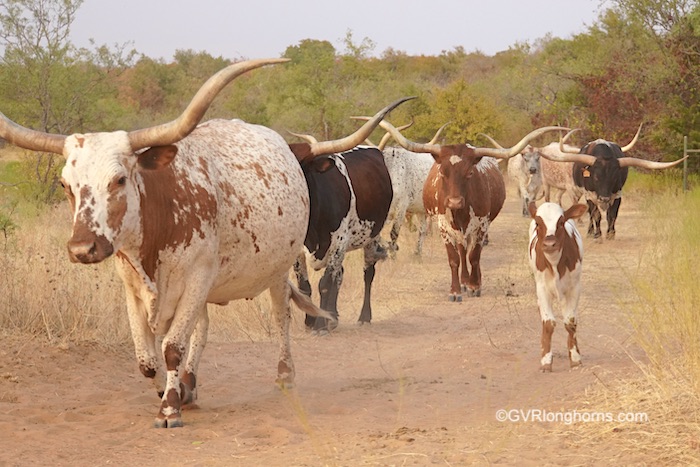In the Texas longhorn cattle industry wide horn measurements from Tip To Tip are so popular that we sometimes overlook other features. However, when it comes to the overall health of our Texas longhorn cattle, it makes sense to extent the triple TTT to include everything from Tip To Toe.
Visit our SALEBARN here
In this article we turn our attention to Texas longhorn cattle “toes” so to speak.
To be honest, we have limited experience with hoof irregularities. Of the hundreds of Texas longhorns we have had over the last two decades, one cow required urgent attention to her toes. We were lucky enough to schedule a ranch visit with Samuel Faske from Hoof’n it Solutions. He is the only Texas longhorn hoof trimming specialist we know who will consider helping a non-haltered Texas longhorn. If you know of others, please let us know. Anyway, because of these limited resources and in order to help others avoid urgent situations with their Texas longhorns’ hooves we had an extended conversation with Samuel and decided to share some of our concerns and answers. We also did a bit of our own research.
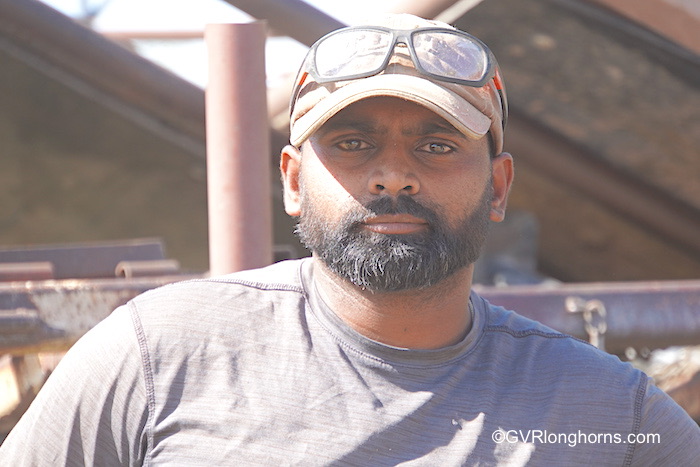
Here is a list of “Toe Tips” that we feel are important for us to know and you may feel the same way too.
The Texas longhorn cattle HOOF
1. Understanding the general anatomy of a cow’s hooves goes a long way in determining what could go wrong.
the very basics,
- Texas longhorn cattle have cloven hooves. Each hoof has two parts or claws.
- In essence, bovine claws are the equivalent of our toes.
- For those who want to know, the outer claw is the lateral claw and the inner claw is the medial claw.
- The claws are not split evenly and the weight they carry varies.
- In fact, longhorns bare their weight from the spine down to their hooves.
- The front legs support more weight than the back legs because the centre of gravity in cattle is located in the chest. Cattle distribute their body weight on a 55%/45% ratio.
- Furthermore, the outer claws of the hind legs generally support the most pressure. Conversely, the inner claws of the front legs support most of the pressure.
- The hoof wall carries most of the weight of a cow. It is the hard part of the hoof. Essentially, it is like our nails.
Picture a ballerina on point and you are on the right track!
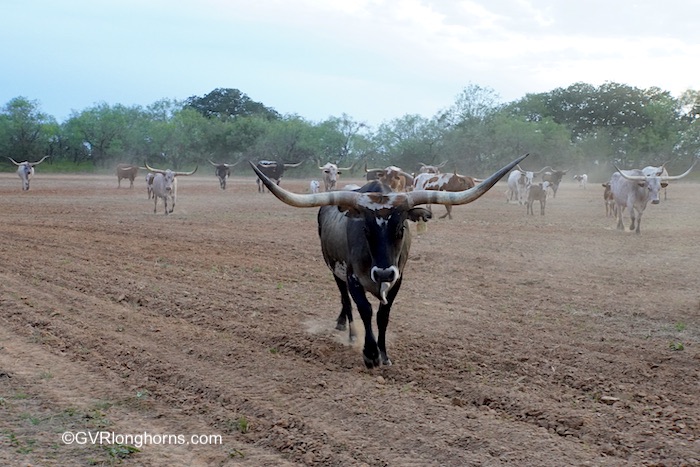
Although cows can be lame for a wide variety of reasons, 90% of the time the cause can be found by examining the foot. College of Veterinary Medicine Cornell University
2. The Texas longhorn cattle HOOF, specifically the hoof wall, is made of Keratin
Like other cattle breeds, a Texas longhorn’s hooves are made of Keratin. Keratin is also found in Texas longhorn cattle horns.
So, the question is, if Texas longhorn cattle horns are longer than they used to be, do their hooves grow longer too?
The answer is not as straightforward as you may think.
Samuel maintains that excessive long horns are not necessarily related to excessive hoof growth. He says that genetics do play a role in the hoof structure of longhorn cattle. However, just like humans, some cattle just have bad feet.
None-the-less, there are other factors that play a role.
3. Factors that could affect hoof health and hoof growth
A) Environmental Conditions:-
- Historically, Texas longhorn cattle roamed open ranges and traveled far distances. Needless to say, cattle hooves wore down naturally. On the contrary, modern-day ranches vary in acreage and are often smaller spaces. Simply put, many Texas longhorn cattle don’t have the opportunity or necessity to walk a lot.
- Furthermore, cattle walk on various types of surfaces. A cow’s feet will look different and will incur different injuries and diseases on hard dry areas, creek bottoms, and rocky outcrops as aposed to soft, plowed, moist pastures.
- Following, according to a paper by Purdue University, the majority of hoof problems in the bovine species affect dairy cows. As an example, living on concrete floors that are wet often from being washed every day opens the possibility for hoof problems to occur.
- Overcrowding causes hygiene issues and is self-explanatory as far as hooves go.
INTERESTINGLY, Samuel has trimmed many breeds of cattle. In his experience, he maintains that Texas longhorn cattle have less issues that relate to disease. In general, Samuel tends to help Texas longhorn cattle ranchers with hoof issues caused by overgrowth.

B) Nutrition:-
- An imbalance in PH in a cow’s rumen or lack of the right supplements and minerals can cause hoof damage.
- Samuel experienced an increase in demand of his hoof trimming services during the Texas drought which he attributed to amongst other things, an increase in protein diet with extended hay feeding. Interestingly, a paper published by Penn State Cooperative Extension Service (specifically referencing dairy cattle) acknowledges that protein plays a role in laminitis even though the exact influence is still unclear.
- Texas longhorn cattle on the show circuit often are on additional feed other than hay. That’s usually not a noticeable issue because show cattle’s hooves are trimmed for aesthetic purposes. On the other hand, cattle ranches who supplement their Texas longhorn cattle to boost horn growth or who are feeding to raise beef, may notice accelerated hoof growth too.
C) Genetics :- let’s face it, Texas longhorn cattle have longer horns now than ever before.
- Samuel has noticed a trend of more growth in hooves in certain genetic families.
- On the other hand, like humans, some cattle just have bad feet no matter how wide their horns are.
All in all, it’s not often that you will hear of a desirable wide-horned Texas longhorn cow that is overlooked because of her bad feet. More and more cows are being bred because of their long horns irrespective of other flaws she may or may not have.
D) Texas longhorn Cattle, in general:-
- Age can be a factor in hoof health
- Overall health of a cow can impact hoof soundness.
4. Why to take action?
- Cows walk on the equivalent of human toe tips, so a slight difference in their hooves’ shape or thickness could upset their balance.
- Hoof trimming should focus on preventing lameness by restoring the correct weight balance between hooves
- The thing is, an imbalance of weight caused by hoof abnormalities could affect other joints and structures if not restored.
- A strategic hoof-trimming program is important to prevent lameness in cows with a history of hoof issues.
- It is true that the majority of hoof problems in the bovine species affect dairy cows. However, aside from direct injury to the hoof, including punctures, ulcers, abscesses, and lacerations, laminitis is the most common non-infectious lameness in cattle.
- Laminitis, as its name suggests, is the inflammation of the laminar tissue which can also cause many other problems in the hoof that otherwise would only occur from direct injury.
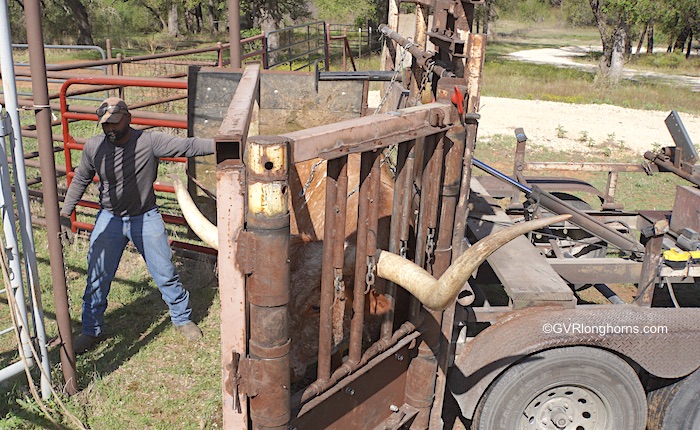

It is important to know that excess hoof growth can cause irritation and uncomfortable pressure on the wrong parts of the foot resulting in an imbalance or change to the gait. This imbalance has an impact right up through the limb to the spine. The pressure can result in the joints changing angle.
Correct hoof trimming is therefore necessary not just to manage the hoof itself but the pressure and inadvertent pain that it causes on the rest of the cow’s body.
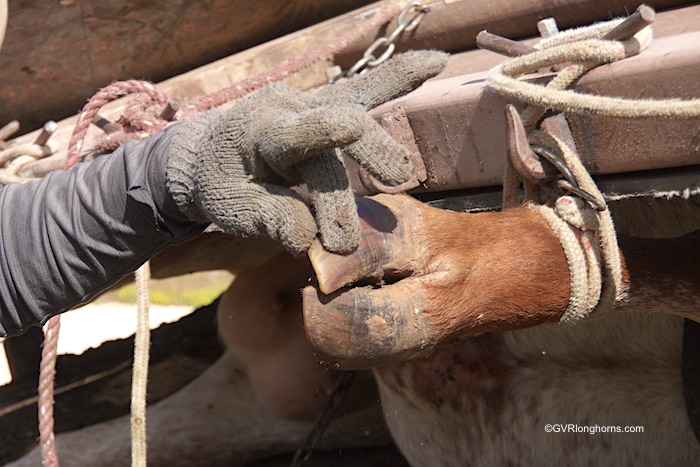
5. When should you have your Texas longhorn cattle’s hooves trimmed?
Different conditions call for different considerations.
Like in most instances, common sense prevails. Take action if any of your answers to one of the following questions is positive:-
- Is your cow is lame? There could be a number of reasons why your cow is lame. If you and your veterinarian have determined that overgrown hooves or other issues related to hooves are an underlying cause for lameness, do not delay taking the necessary steps to have your cows’ hooves trimmed. As Samuel says, ” a cow with no legs is literally ground beef!”
- Does your cow have cracked hooves? Cracks will generally not heal themselves. They will get worse. Speak to your vet about nutrition if this is not isolated to one cow in a big herd.
- Does your cow have overgrown hooves? Overgrown hooves often manifest in crossed claws. The more the claws cross the more exposed a cow will be to hoof related problems that can ultimately lead to lameness.
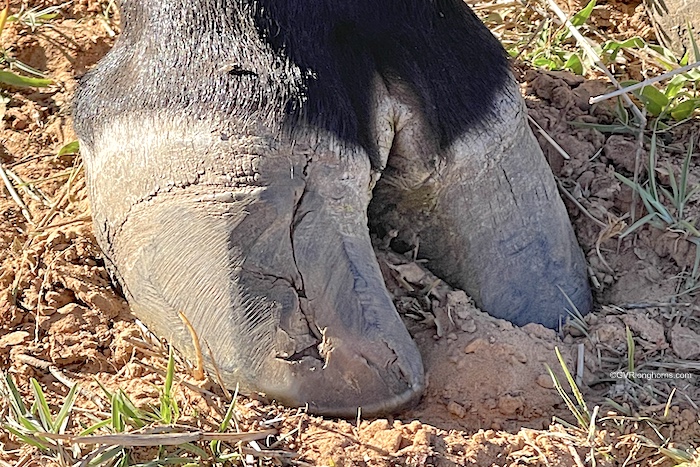
In Conclusion
Frankly, Texas longhorn cattle and farriers are not often considered in the same sentence. As a matter of fact, most of our oldest Texas longhorns have never had their hooves trimmed. After all, we have Texas longhorn cattle because of their low maintenance. But, a cow that cannot walk, cannot feed. Rather than having problems fester under your nose, or should we say, under your cows’ toes, being aware of potential problems goes a long way in preventing them from happening.
A precautionary note: a bad hoof trimming can be just as detrimental as a bad hoof. Don’t delay, call an experienced hoof trimmer, call Samuel Faske today!
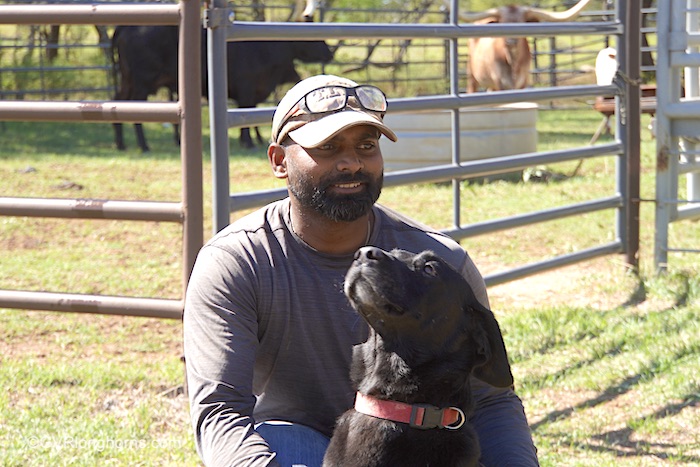
Samuel’s Cell (979) 203-8979 – be sure to let him know you read the article.
Additional references:-
Foot Health College of Veterinary Medicine, Cornell University
PennState Extension,Impacts of Lameness – Part 1: Preventing Lame Cows
The American Dairymen, Hoof Cracks in Dairy Cattle Published on Thu, 06/09/2022 – 10:15am
Diagnostics of a disaster: Skin and foot concerns during floods by
Prevention and Control of Foot Problems in Dairy Cows
Please let us know how you feel about this post in the comments below or email us directly and if you enjoyed reading this article, please consider sharing it.
IF YOU WOULD LIKE TO RECOMMEND SAMUEL TO OTHER TEXAS LONGHORN LOVERS, PLEASE CONSIDER LEAVING YOUR COMMENTS AND TESTIMONIALS BELOW.
Thank you for spending time with us,
Cathy

